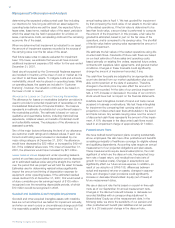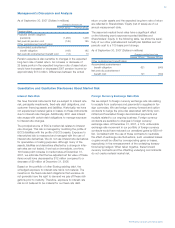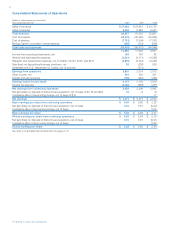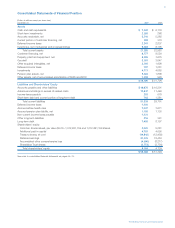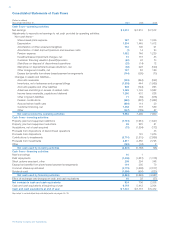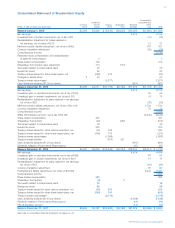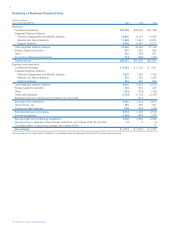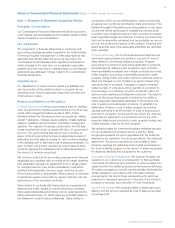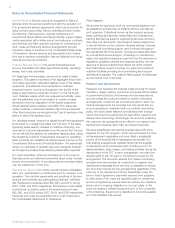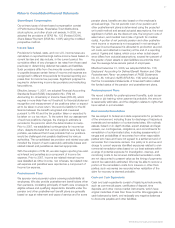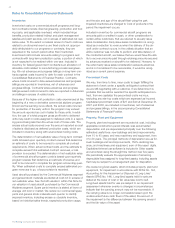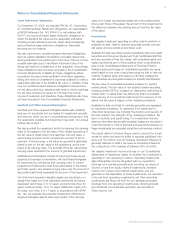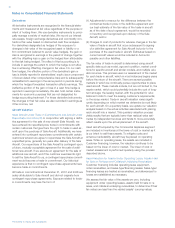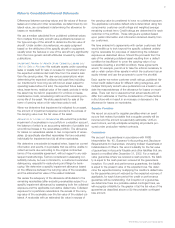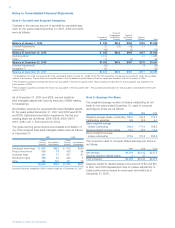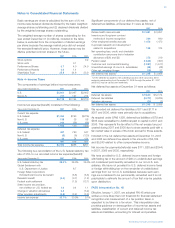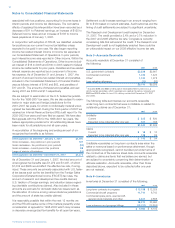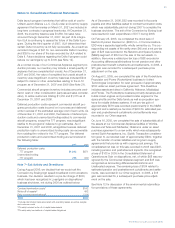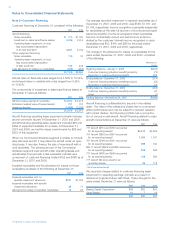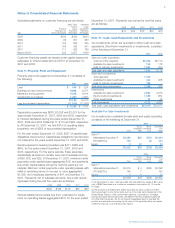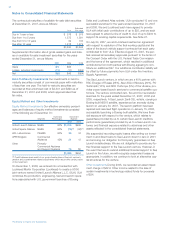Boeing 2007 Annual Report Download - page 51
Download and view the complete annual report
Please find page 51 of the 2007 Boeing annual report below. You can navigate through the pages in the report by either clicking on the pages listed below, or by using the keyword search tool below to find specific information within the annual report.48
Notes to Consolidated Financial Statements
Inventories
Inventoried costs on commercial aircraft programs and long-
term contracts include direct engineering, production and tool-
ing costs, and applicable overhead, which includes fringe
benefits, production related indirect and plant management
salaries and plant services, not in excess of estimated net real-
izable value. To the extent a material amount of such costs are
related to an abnormal event or are fixed costs not appropri-
ately attributable to our programs or contracts, they are
expensed in the current period rather than inventoried.
Inventoried costs include amounts relating to programs and
contracts with long-term production cycles, a portion of which
is not expected to be realized within one year. Included in
inventory for federal government contracts is an allocation of
allowable costs related to manufacturing process reengineer-
ing. We net advances and progress billings on long-term con-
tracts against costs incurred to date for each contract in the
Consolidated Statements of Financial Position. Contracts
where costs incurred to date exceed advances and progress
billings are reported in Inventories, net of advances and
progress billings. Contracts where advances and progress
billings exceed costs incurred to date are reported in Advances
and billings in excess of related costs.
Because of the higher unit production costs experienced at the
beginning of a new or derivative commercial airplane program
(known as the learning curve effect), the actual costs incurred
for production of the early units in the program may exceed
the amount reported as cost of sales for those units. In addi-
tion, the use of a total program gross profit rate to delivered
units may result in costs assigned to delivered units in a report-
ing period being less than the actual cost of those units. The
excess actual costs incurred over the amount reported as cost
of sales is disclosed as deferred production costs, which are
included in inventory along with unamortized tooling costs.
The determination of net realizable value of long-term contract
costs is based upon quarterly contract reviews that determine
an estimate of costs to be incurred to complete all contract
requirements. When actual contract costs and the estimate to
complete exceed total estimated contract revenues, a loss
provision is recorded. The determination of net realizable value
of commercial aircraft program costs is based upon quarterly
program reviews that determine an estimate of revenue and
cost to be incurred to complete the program accounting quan-
tity. When estimated costs to complete exceed estimated pro-
gram revenues to go, a loss provision is recorded.
Used aircraft purchased by the Commercial Airplanes segment
and general stock materials are stated at cost not in excess of
net realizable value. See ‘Aircraft valuation’ within this Note for
our valuation of used aircraft purchased by the Commercial
Airplanes segment. Spare parts inventory is stated at lower of
average unit cost or market. We review our commercial spare
parts and general stock materials each quarter to identify
impaired inventory, including excess or obsolete inventory,
based on historical sales trends, expected production usage,
and the size and age of the aircraft fleet using the part.
Impaired inventories are charged to Cost of products in the
period the impairment occurs.
Included in inventory for commercial aircraft programs are
amounts paid or credited in cash, or other consideration to
certain airline customers, that are referred to as early issue
sales consideration. Early issue sales consideration is recog-
nized as a reduction to revenue when the delivery of the air-
craft under contract occurs. In the unlikely situation that an
airline customer was not able to perform and take delivery of
the contracted aircraft, we believe that we would have the abil-
ity to recover amounts paid through retaining amounts secured
by advances received on aircraft to be delivered. However, to
the extent early issue sales consideration exceeds advances
and is not considered to be recoverable, it would be recog-
nized as a current period expense.
Precontract Costs
We may, from time to time, incur costs to begin fulfilling the
statement of work under a specific anticipated contract that
we are still negotiating with a customer. If we determine it is
probable that we will be awarded the specific anticipated con-
tract, then we capitalize the precontract costs we incur,
excluding any start-up costs which are expensed as incurred.
Capitalized precontract costs of $27 and $40 at December 31,
2007 and 2006, are included in Inventories, net of advances
and progress billings, in the accompanying Consolidated
Statements of Financial Position.
Property, Plant and Equipment
Property, plant and equipment are recorded at cost, including
applicable construction-period interest, less accumulated
depreciation and are depreciated principally over the following
estimated useful lives: new buildings and land improvements,
from 10 to 40 years; and new machinery and equipment, from
3 to 20 years. The principal methods of depreciation are as fol-
lows: buildings and land improvements, 150% declining bal-
ance; and machinery and equipment, sum-of-the-years’ digits.
Capitalized internal use software is included in Other assets
and amortized using the straight line method over five years.
We periodically evaluate the appropriateness of remaining
depreciable lives assigned to long-lived assets, including assets
that may be subject to a management plan for disposition.
We review long-lived assets, which includes property, plant and
equipment, for impairment in accordance with SFAS No. 144,
Accounting for the Impairment or Disposal of Long-Lived
Assets (SFAS No. 144). Long-lived assets held for sale are
stated at the lower of cost or fair value less cost to sell.
Long-lived assets held for use are subject to an impairment
assessment whenever events or changes in circumstances
indicate that the carrying amount may not be recoverable. If
the carrying value is no longer recoverable based upon the
undiscounted future cash flows of the asset, the amount of
the impairment is the difference between the carrying amount
and the fair value of the asset.
The Boeing Company and Subsidiaries


